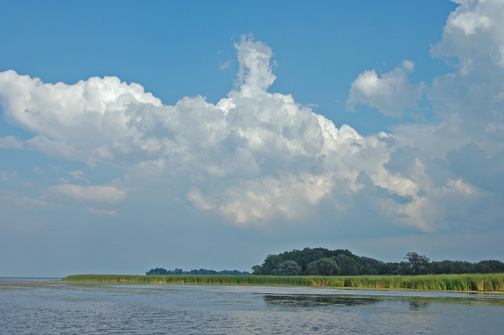 What does the NYS Department of Health say about the algae blooms in the bays and ponds along the southern shore of New York State? "Blue-green algae, technically known as cyanobacteria, are microscopic organisms that are naturally present in lakes and streams. They usually are present in low numbers. Blue-green algae can become very abundant in warm, shallow, undisturbed surface water that receives a lot of sunlight. When this occurs, they can form blooms that discolor the water or produce floating rafts or scums on the surface of the water."
What does the NYS Department of Health say about the algae blooms in the bays and ponds along the southern shore of New York State? "Blue-green algae, technically known as cyanobacteria, are microscopic organisms that are naturally present in lakes and streams. They usually are present in low numbers. Blue-green algae can become very abundant in warm, shallow, undisturbed surface water that receives a lot of sunlight. When this occurs, they can form blooms that discolor the water or produce floating rafts or scums on the surface of the water."
"What are the potential health effects from drinking or coming in contact with water containing blue-green algae?"
"Some blue-green algae produce toxins that could pose a health risk to people and animals when they are exposed to them in large enough quantities. Health effects could occur when surface scums or water containing high levels of blue-green algal toxins are swallowed, through contact with the skin or when airborne droplets containing toxins are inhaled while swimming, bathing or showering.
Consuming water containing high levels of blue-green algal toxins has been associated with effects on the liver and on the nervous system in laboratory animals, pets, livestock and people. Livestock and pet deaths have occurred when animals consumed very large amounts of accumulated algal scum from along shorelines.
Direct contact or breathing airborne droplets containing high levels of blue-green algal toxins during swimming or showering can cause irritation of the skin, eyes, nose and throat and inflammation in the respiratory tract.
Recreational contact, such as swimming, and household contact, such as bathing or showering, with water not visibly affected by a bluegreen algae bloom is not expected to cause health effects. However, some individuals could be especially sensitive to even low levels of algal toxins and might experience mild symptoms such as skin, eye or throat irritation or allergic reactions." -- http://www.nyhealth.gov/environmental/water/drinking/bluegreenalgae.htm -- posted by Barbara












